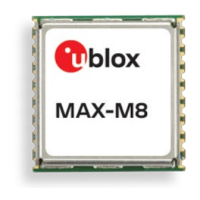MAX-8 / MAX-M8 - Hardware Integration Manual
UBX-15030059 - R05 Hardware description Page 7 of 31
Production Information
⚠ This string has to be sent once in production and will permanently turn off the single crystal
feature on MAX-8C / MAX-M8C. The hot start and warm start performance will be degraded if time
information is not provided to the receiver at every startup.
1.3.3 VCC_RF: Output voltage RF
The VCC_RF pin can be used to supply an active antenna or an external LNA. For more information,
see section 2.4.
1.3.4 V_ANT: Antenna supply (MAX-M8W)
At V_ANT pin an antenna supply voltage can be connected which will be provided at RF_IN to supply
an active antenna. For more information see section 2.4.3
.
☞ If not used, connect the V_ANT pin to GND.
1.4 Interfaces
1.4.1 UART
u-blox MAX-8 / MAX-M8 positioning modules include a Universal Asynchronous Receiver Transmitter
(UART) serial interface RXD/TXD that supports configurable baud rates. The UART output and input
levels are 0 V to VCC_IO. An interface based on RS232 standard levels (+/- 12 V) can be implemented
using level shifters such as Maxim MAX3232. Hardware handshake signals and synchronous
operation are not supported.
1.4.2 Display Data Channel (DDC)
An I
2
C compatible Display Data Channel (DDC) interface is available with u-blox MAX-8 / MAX-M8
modules for serial communication with an external host CPU. The interface only supports operation
in slave mode (master mode is not supported). The DDC protocol and electrical interface are fully
compatible with the Fast-Mode of the I
2
C industry standard. DDC pins SDA and SCL have internal
pull-up resistors to VCC_IO.
For more information about the DDC implementation, see the
u-blox 8 /
u-blox M8 Receiver
Description Including Protocol Specification
[3]. For bandwidth information, see the
MAX-8 Data
Sheet
[1] and
MAX-M8 Data Sheet
[2]. For timing, parameters consult the
I
2
C-bus specification
[6].
☞ The u-blox MAX-8 / MAX-M8 DDC interface supports serial communication with u-blox cellular
modules. See the specification of the applicable cellular module to confirm compatibility.
1.4.3 TX_READY
The TX_READY function is used to indicate when the receiver has data to transmit. A listener can wait
on the TX_READY signal instead of polling the DDC or SPI interfaces. The UBX-CFG-PRT message lets
you configure the polarity and the number of bytes in the buffer before the TX READY signal goes
active. The TX_READY function can be mapped to TXD (PIO 06). The TX_READY function is disabled
by default.
☞ The TX_READY functionality can be enabled and configured by AT commands sent to the u-blox
cellular module supporting the feature. For more information, see the
GPS Implementation and
Aiding Features in u-blox wireless modules
[7].
1.5 I/O pins
All I/O pins make use of internal pull-ups. Thus, there is no need to connect unused pins to VCC_IO.

